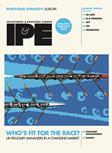Moulding yourself to the system
As pension funds and investment firms come to rely more heavily on technology, they need to know how to get the best out of what can be a considerable investment. Part of the trick is making the right choice of system, but much can also be gained or lost in ...
You have now reached your article limit
Already a registered user or member? Sign in here
To continue reading, register free today for access
Registration also includes access to

Five reasons to register today
- Access to IPE articles from our award-winning editorial team
- Unique IPE market data, rankings and tables
- In-depth interviews with pension fund leaders
- Extensive coverage of latest asset class trends
- Comprehensive archive of data, research and intelligence






